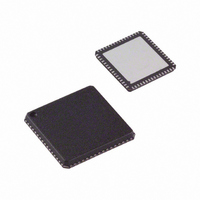AD9516-1BCPZ Analog Devices Inc, AD9516-1BCPZ Datasheet - Page 34

AD9516-1BCPZ
Manufacturer Part Number
AD9516-1BCPZ
Description
IC,Fourteen Distributed-Output Clock Driver,LLCC,64PIN,PLASTIC
Manufacturer
Analog Devices Inc
Type
Clock Generator, Fanout Distributionr
Datasheet
1.AD9516-1BCPZ-REEL7.pdf
(80 pages)
Specifications of AD9516-1BCPZ
Pll
Yes
Input
Clock
Output
CMOS, LVDS, LVPECL
Number Of Circuits
1
Ratio - Input:output
1:14
Differential - Input:output
Yes/Yes
Frequency - Max
2.65GHz
Divider/multiplier
Yes/No
Voltage - Supply
3.135 V ~ 3.465 V
Operating Temperature
-40°C ~ 85°C
Mounting Type
Surface Mount
Package / Case
64-LFCSP
Frequency-max
2.65GHz
Lead Free Status / RoHS Status
Lead free / RoHS Compliant
For Use With
AD9516-1/PCBZ - BOARD EVALUATION FOR AD9516-1
Lead Free Status / RoHS Status
Lead free / RoHS Compliant
Available stocks
Company
Part Number
Manufacturer
Quantity
Price
Company:
Part Number:
AD9516-1BCPZ
Manufacturer:
ADI
Quantity:
591
Part Number:
AD9516-1BCPZ
Manufacturer:
ADI/亚德诺
Quantity:
20 000
AD9516-1
In differential mode, the reference input pins are internally self-
biased so that they can be ac-coupled via capacitors. It is possible to
dc couple to these inputs. If the differential REFIN is driven by
a single-ended signal, the unused side ( REFIN ) should be
decoupled via a suitable capacitor to a quiet ground. Figure 49
shows the equivalent circuit of REFIN.
Reference Switchover
The AD9516 supports dual single-ended CMOS inputs, as well
as a single differential reference input. In the dual single-ended
reference mode, the AD9516 supports automatic and manual
PLL reference clock switching between REF1 (on Pin REFIN)
and REF2 (on Pin REFIN ). This feature supports networking
and other applications that require smooth switching of redundant
references. When used in conjunction with the automatic
holdover function, the AD9516 can achieve a worst-case
reference input switchover with an output frequency disturbance as
low as 10 ppm.
When using reference switchover, the single-ended reference
inputs should be dc-coupled CMOS levels and never be allowed
to go to high impedance. If these inputs are allowed to go to high
impedance, noise may cause the buffer to chatter, causing a
false detection of the presence of a reference.
Reference switchover can be performed manually or auto-
matically. Manual switchover is performed either through
Register 0x01C or by using the REF_SEL pin. Manual switchover
requires the presence of a clock on the reference input that is
being switched to, or that the deglitching feature be disabled
(Register 0x01C[7]). The reference switching logic fails if this
condition isn’t met, and the PLL does not reacquire.
REFIN
REFIN
REF1
REF2
Figure 49. REFIN Equivalent Circuit
10kΩ
10kΩ
85kΩ
85kΩ
12kΩ
10kΩ
V
V
150Ω
150Ω
S
S
V
S
Rev. A | Page 34 of 80
Automatic revertive switchover relies on the REFMON pin to
indicate when REF1 disappears. By programming Register 0x01B =
0xF7 and Register 0x01C = 0x26, the REFMON pin is programmed
to be high when REF1 is invalid, which commands the switch to
REF2. When REF1 is valid again, the REFMON pin goes low, and
the part again locks to REF1. It is also possible to use the STATUS
pin for this function, and REF2 can be used as the preferred
reference.
A switchover deglitch feature ensures that the PLL does not
receive rising edges that are far out of alignment with the newly
selected reference.
Automatic nonrevertive switching is not supported.
Reference Divider R
The reference inputs are routed to the reference divider, R.
R (a 14-bit counter) can be set to any value from 0 to 16383 by
writing to Register 0x011 and Register 0x012. (Both R = 0 and
R = 1 give divide-by-1.) The output of the R divider goes to one
of the PFD inputs to be compared to the VCO frequency
divided by the N divider. The frequency applied to the PFD
must not exceed the maximum allowable frequency, which
depends on the antibacklash pulse setting (see Table 2).
The R counter has its own reset. R counter can be reset using
the shared reset bit of the R, A, and B counters. It can also be
reset by a SYNC operation.
VCXO/VCO Feedback Divider N—P, A, B, R
The N divider is a combination of a prescaler (P) and two
counters, A and B. The total divider value is
where the value of P can be 2, 4, 8, 16, or 32.
Prescaler
The prescaler of the AD9516 allows for two modes of operation:
a fixed divide (FD) mode of 1, 2, or 3, and dual modulus (DM)
mode where the prescaler divides by P and (P + 1) {2 and 3, 4
and 5, 8 and 9, 16 and 17, or 32 and 33}. The prescaler modes of
operation are given in Table 54, Register 0x016[2:0]. Not all
modes are available at all frequencies (see Table 2).
When operating the AD9516 in dual modulus mode (P//P + 1),
the equation used to relate input reference frequency to VCO
output frequency is
However, when operating the prescaler in FD mode, 1, 2, or 3,
the A counter is not used (A = 0) and the equation simplifies to
When A = 0, the divide is a fixed divide of P = 2, 4, 8, 16, or 32,
in which case the previous equation also applies.
N = (P × B) + A
f
f
VCO
VCO
= (f
= (f
REF
REF
/R) × (P × B + A) = f
/R) × (P × B) = f
REF
× N/R
REF
× N/R
















